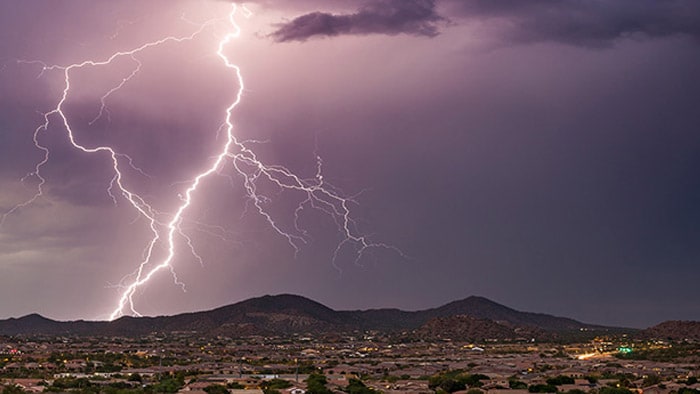Key points
- Go inside if you hear thunder or see lightning.
- If someone was struck by lightning, call for help, assess the situation, respond, and resuscitate.
- Learn indoor and outdoor safety tips to protect yourself and your loved ones from lightning.
Indoors

Even though your home is a safe shelter during a lightning storm, you might still be at risk. About one-third of lightning-strike injuries occur indoors. Here are some tips to keep safe and reduce your risk of being struck by lightning while indoors.
Avoid water.
- Do NOT bathe, shower, wash dishes, or have any other contact with water during a thunderstorm because lightning can travel through a building’s plumbing
- The risk of lightning travelling through plumbing might be less with plastic pipes than with metal pipes. However, it is best to avoid any contact with plumbing and running water during a lightning storm to reduce your risk of being struck.
Don't touch electronic equipment.
Lightning can travel through electrical systems, radio and television reception systems, and any metal wires or bars in concrete walls or flooring.
- Do NOT use anything connected to an electrical outlet, such as computers, laptops, game systems, washers, dryers, or stoves.
- Equip your home with whole-house surge protectors to protect your appliances.
Avoid windows, doors, porches, and concrete.
- Stay away from windows and doors, and stay off porches.
- Do NOT lie on concrete floors or lean on concrete walls during a thunderstorm. Lightning can travel through any metal wires or bars in concrete walls or flooring.
Don't use corded phones.
Corded phones are NOT safe to use during a thunderstorm. Do NOT use them. However, it is safe to use cordless or cellular phones during a storm.
Protect your pets.
Your pets cannot protect themselves from lightning; it is your responsibility to help protect them. Remove any metal collars, leashes, or harnesses and replace with plastic. Even though metal does not attract electricity, it is a good conductor and can make injuries, such as burns, worse if struck.
Outdoors

Although no place outside is safe during a thunderstorm, you can minimize your risk by assessing the lightning threat early and taking appropriate actions. The best defense is to avoid lightning. Here are some outdoor safety tips that can help you avoid being struck.
Be aware. Check the forecast.
Thunderstorms with lightning in the mountains occur most often during the summer months, in the late afternoon or evening.
- Check the weather forecast before participating in outdoor activities.
- If the forecast calls for thunderstorms, postpone your trip or activity, or make sure suitable safe shelter is readily available.
Beach and water activities
Pay extra attention to developing storms if you are at the beach or boating.
Listen to the forecast.
It is crucial to listen to weather information when you are at the beach or boating. Short-term forecasts are quite accurate, but sometimes miss some very localized storms.
Learn how to read the weather.
- Watch for the development of large, well-defined rising cumulus clouds. Cumulus clouds have flat bases and dome or cauliflower shapes. Cumulus clouds can develop into thunderstorms.
- Once the clouds reach 30,000 feet, the thunderstorm is generally developing, and it is time to head for shore. As clouds become darker and more anvil-shaped, the storm is already in progress.
Watch and listen for distant storm activity.
- Watch for distant lightning and listen for distant thunder. You might hear thunder before you see lightning on a bright day.
- If you hear thunder or see lightning, seek shelter away from the water.
When thunder roars, go indoors.
Remember the phrase, "When thunder roars, go indoors."
- Find a safe, enclosed shelter when you hear thunder. Even if you see blue sky, you could still be in danger.
- Don't resume outdoor activities for at least 30 minutes after the storm. The beginning and the end of a storm are the most dangerous times.
- If you hear thunder while you are at the beach, find a safe, enclosed shelter, such as your car. Do NOT seek shelter under beach picnic shelters.
Avoid open spaces, vehicles, or structures.
- Stay away from open spaces such as golf courses, parks, playgrounds, ponds, lakes, swimming pools, and beaches.
- Avoid open vehicles such as convertibles, motorcycles, and golf carts.
- Avoid open structures such as porches, gazebos, baseball dugouts, and sports arenas. These structures won’t protect you from lightning.
Choose a safe shelter
Don't leave your pet outdoors.
Do NOT leave your pet outdoors or chained to a tree during a lightning storm. Doghouses are NOT safe shelters; bring your pet inside.
Seek shelter immediately, even if caught out in the open.
If you are caught in an open area, act quickly to find shelter. The most important action is to remove yourself from danger. Crouching or getting low to the ground can reduce your chances of being struck, but it does not remove you from danger.
If you are caught outside with no safe shelter nearby:
- Immediately get off elevated areas such as hills, mountain ridges, or peaks.
- Never lie flat on the ground. Crouch down in a ball-like position with your head tucked and hands over your ears so that you are down low with minimal contact with the ground.
- Never shelter under an isolated tree. If you are in a forest, shelter near lower trees.
- Never use a cliff or rocky overhang for shelter.
- Immediately get out of and away from ponds, lakes, and other bodies of water.
- Stay away from objects that conduct electricity (such as barbed wire fences, power lines, or windmills).
If you are out in the open water and a storm rolls in, return to shore immediately.
- If you are on a boat in open water when a thunderstorm rolls in, return to shore immediately and seek shelter. Once on land, get at least 100 yards away from shore.
- If you are unable to return to shore, boats with cabins offer some protection. When inside the cabin during a lightning storm, stay away from all metal and electrical components, including the radio, unless it is an emergency.
- If caught in a storm in a small boat with no cabin, drop anchor and get as low as possible.
Protect your boat
Separate from others.
If you are in a group during a thunderstorm, separate from each other. This will reduce the number of injuries if lightning strikes the ground.
Don't stay near tall structures.
Stay away from tall structures, such as telephone poles and trees; lightning tends to strike the tallest object around.
Don't carry metal.
- Don't carry any metal objects, such as golf clubs, fishing poles, umbrellas, or backpacks with metal frames. Metal doesn't attract electricity, but it is a good conductor. Your chances of a direct hit are higher when you are carrying a conductor above shoulder level.
- Be sure to avoid other metal objects as well, such as wire fences. You are more likely to be burned if you are in contact with metal when you are struck by lightning.
First Aid Recommendations

Giving first aid to a person who has been struck by lightning while waiting for professional medical attention can save their life. It is safe to touch people who have been struck by lightning; they DO NOT carry an electrical charge.
Follow these four steps immediately to help save the life of a person who has been struck by lightning:
Call for help.
- Call 911 immediately—It is safe to use a cell phone or cordless phone during a storm.
- Give directions to your location and information about the person.
Items to Note When Calling for Help
Assess the situation.
Safety is a priority. Be aware of the continued lightning danger to both the person who has been struck and the rescuer.
- If located in a high-risk area (for example, near an isolated tree or in an open field), you could be in danger. If necessary, move to a safer location.
- If it's safe to do so, move the victim to reduce the risk of further exposure to lightning. Do not move victims who are bleeding or appear to have broken bones.
It is unusual for a person who has survived a lightning strike to have any major broken bones that would cause paralysis or major bleeding complications, unless the person suffered a fall or was thrown a long distance.
Please Note
Respond.
Lightning often causes a heart attack.
- Check to see if the person is breathing and has a heartbeat.
- The best places to check for a pulse are the carotid artery in the neck and the femoral artery in the groin.

If the person is breathing normally, look for other possible injuries.
Lightning can cause burns, shock, and sometimes blunt trauma.
- Treat each of these injuries with basic first aid until help arrives.
- If the area is cold and wet, putting a protective layer, such as a jacket, blanket, or plastic sheet, between the person and the ground may help decrease hypothermia (abnormally low body temperature).
Resuscitate.
- If the person is not breathing, immediately begin mouth-to-mouth rescue breaths.
- If they do not have a pulse, start chest compressions as well (CPR).
- Continue resuscitation efforts until help arrives.
